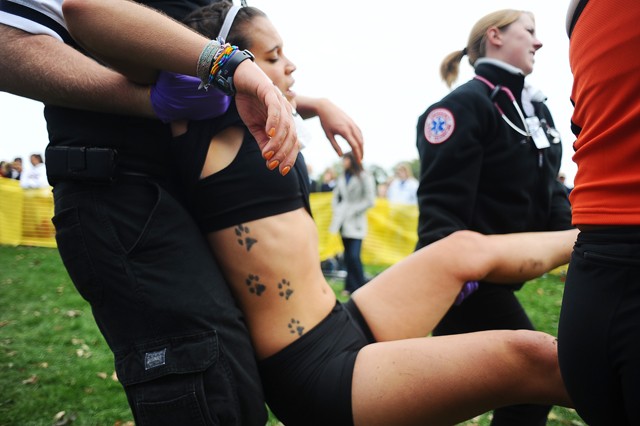For a fan experiencing a cross country meet for the first time âÄî especially one the size of the Roy Griak Invitational âÄî the sheer volume of runners who need medical assistance can be disconcerting. Not to mention the sight of thousands of haggard runners crossing the finish line, many of them stumbling and vomiting soon after. To athletes, however, itâÄôs just part of the ballgame. âÄúCross country takes a special kind of athlete because the mark of a good race is when you get to the end you have nothing left,âÄù assistant coach Sarah Hesser said. One of the primary focuses in a cross country race is the pacing, but with about 100 meters left, that goes out the window, Hesser said. When athletes push to âÄî or beyond âÄî the point of their physical limitations, the ultimate concern is what Hesser described as âÄúoxygen debt.âÄù Rob Johnson, who has run every Twin Cities marathon and is the team physician for six colleges including Minnesota, said oxygen debt refers to âÄúwhether or not your metabolic system can get enough oxygen to produce fuel.âÄù Maximal oxygen uptake refers to the highest rate that an athlete can draw in oxygen to the blood and muscles. There is a point in any athletic event that oxygen demand surpasses oxygen availability, and thatâÄôs when competitors encounter problems like light headedness and muscle fatigue. The problem is exacerbated in females, who generally have lower overall oxygen intake opportunity. That oxygen debt leads to lactate accumulation in the muscle, Johnson said, which can lead to muscles performing inefficiently. Medical personnel are always on hand at the finish line of a race in a tent where Peterson said they can test blood pressure and temperature of an athlete, as well as administer nutrients intravenously. There are people whose sole focus is to catch runners who can no longer physically stand under their own power. Cole Peterson is the athletic trainer for the cross country team. He said at a meet the size of Griak, the team uses 12 certified trainers, 11 team physicians, five Emergency Medical Technicians, 10 student interns and a host of track and field student-athlete volunteers. âÄúThe main thing we worry about is if someone has pre-existing injuries like asthma, and begins having an attack,âÄù he said. No athletes were taken to the hospital at this yearâÄôs Griak, but Peterson said theyâÄôve had to hospitalize two athletes in his three years with the team. âÄúWe tell our girls that we want you to be able to run 6,001 meters and then youâÄôre done,âÄù Hesser said. That mentality can have a startling impact on a runnerâÄôs physical abilities after crossing the finish line. âÄúYou see a lot of people who, by the end of the race, are pretty darn out of it. If they had to go another 50 meters, it wouldnâÄôt happen,âÄù Peterson said. Hesser added, âÄúphysiologically, youâÄôre putting yourself in a pretty big deficit if you run to the point you canâÄôt stand up upon completing the race âĦ ItâÄôs almost like getting sick, once youâÄôve pushed your body to that limit, itâÄôs tough to recover.âÄù The cross country coaches said they acknowledge a fine line between pushing physical limitations and being rational with oneâÄôs body. Whenever athletes complete a race or workout and feel they have nothing left, a light day of workouts will generally follow. The athletes who struggled physically upon completion of the Griak will take Sunday, Monday and Tuesday light in order to fully recover, Hesser said. âÄúI think it takes a somewhat masochistic mentality at times knowing how much itâÄôs going to hurt going into a race,âÄù Hesser said. At its core, long distance running is a simple event âÄî endure long enough both physically and mentally to outdistance the opponents. According to Hesser, a former distance runner herself, there comes a certain point when it becomes necessary to simply survive. âÄúItâÄôs all about from the shoulders up. At a certain point it has nothing to do with your fitness,âÄù she said. âÄúWe always say itâÄôs 100 percent physical and 100 percent mental.âÄù Added Johnson, âÄúthe body is remarkable. If itâÄôs trained, itâÄôs going to recover.âÄù Related: – Price takes second in the Griak (9/26) – Roy Griak Invitational 2010 (video) – Thousands of runners coming for Griak Invitational (9/22)

















